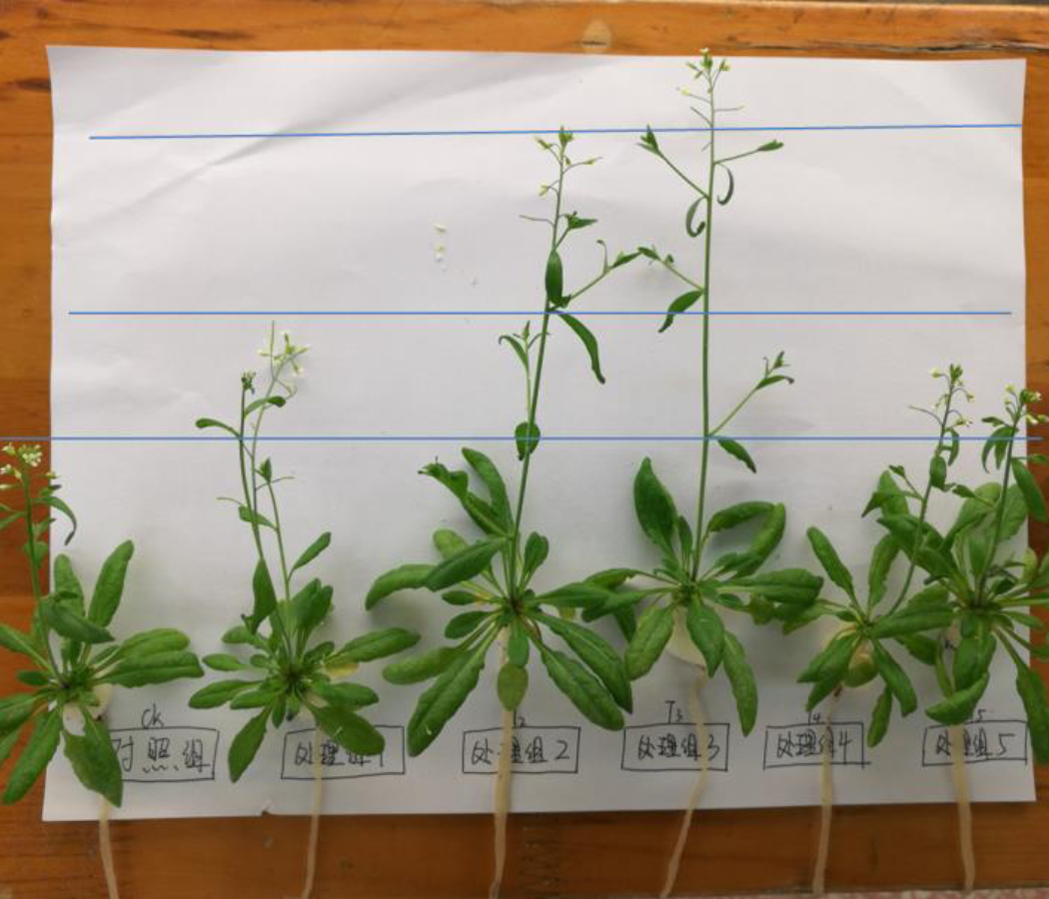

荧光粉激发型LED光对拟南芥生长发育的影响
收稿日期: 2017-05-16
录用日期: 2017-12-26
网络出版日期: 2018-09-11
基金资助
湖南农业大学作物种质创新与资源利用重点实验室开发课题(No.15KFXM06)、湖南省自然科学基金(No.2016JJ3065)和国家自然科学基金(No.21706060)
The Effects of Different Phosphor Excitation-type LED Lighting on the Growth and Development of Arabidopsis
Received date: 2017-05-16
Accepted date: 2017-12-26
Online published: 2018-09-11
在室内人工光源照射条件下, 探究150 μmol∙m-2·s-1光强下不同比例的红蓝光对拟南芥(Arabidopsis thaliana)生长发育的影响。以哥伦比亚(Columbia-0)野生型拟南芥为研究对象, 采用荧光粉激发型LED作为植物生长光源, 以SrSiAlN3为红色基底, 调节荧光粉添加量获得不同红蓝光谱, 考察不同光照条件下拟南芥萌发率、根长、株高、叶绿素含量和相对电导率等参数的变化规律。结果表明, 在荧光粉激发型LED光照调节下的拟南芥具有更高的萌发率、根长、株高、叶绿素含量和相对电导率, 且在红蓝光质比为2:1时萌发率(95.63%)和叶绿素含量(26.7)最高; 在红蓝光质比为4:5时根长(4.19 cm)较长; 在红蓝光质比为4:1时株高(15.5 cm)较高; 在红蓝光质比为4:5时相对电导率(40.5 S·m-1)较大。研究结果表明相对平衡的光质(红蓝光质比为4:1)有利于拟南芥生长发育, 且减少蓝光比例对根系生长及叶绿素积累有一定的促进作用。研究表明不同光谱对模式植物拟南芥的生长发育有较明显的影响, 改变光谱组成可以对植物的生长发育起不同程度的调控作用。

周智, 张永丽, 王变变, 盖淑杰, 王若仲, 卢向阳, 李瑞莲 . 荧光粉激发型LED光对拟南芥生长发育的影响[J]. 植物学报, 2018 , 53(4) : 502 -508 . DOI: 10.11983/CBB17097
To investigate the effects of different red and blue bands on the growth and development of Arabidopsis, we used the model plant Arabidopsis thaliana Columbia-0 to observe the relation between light quality and plant growth. The phosphor excitation-type LED lighting affords an adjustable light spectrum by adjusting the amount of the nitride-based phosphor SrSiAlN3:Eu2+. The germination rate, root length, variation in plant height, chlorophyll content, conductivity and other parameters of the model plant under different light spectra were studied. The germination rate could reach 95.63% and the content of chlorophyll by SPAD meter was up to 26.7 with a red to blue band ratio of 2:1. Root length was much longer and could even reach 4.19 cm under a ratio of 4:5. The height showed the highest value of 15.5 cm with a red to blue band ratio of 4:1, and conductivity was as high as 40.5 S·m-1 with a ratio of 4:5. Maintaining the relative balance of red and blue light can have a positive effect on growth of Arabidopsis, and decreasing the ratio of blue light will benefit the growth of roots and accumulation of chlorophyll. Different light spectra have a great influence on the growth and deve- lopment of the model plant Arabidopsis, and the spectral adjustments can be one of the most important environmental factors for plant research.

| 1 | 曹刚 (2013). 不同LED光质对黄瓜和结球甘蓝苗期生长、光合特性及内源激素的影响. 博士论文. 兰州: 甘肃农业大学. pp. 18-21. |
| 2 | 崔瑾, 徐志刚, 邸秀茹 (2008). LED在植物设施栽培中的应用和前景. 农业工程学报 24(8), 249-253. |
| 3 | 邸秀茹, 焦学磊, 崔瑾, 刘晓英, 孔燕, 徐志刚 (2008). 新型光源LED辐射的不同光质配比光对菊花组培苗生长的影响. 植物生理学通讯 44, 661-664. |
| 4 | 高振, 雷恒树, 吴雨霏, 万继花, 董飞, 王红清 (2016). 不同比例红蓝光对草莓生长和叶片光合特性的影响. 中国农业大学学报 21(12), 20-27. |
| 5 | 李海达, 吉家曾, 郑桂建, 刘厚诚, 雷炳富 (2014). 不同LED补光光源对樱桃番茄产量和品质的影响. 广东农业科学 41(14), 37-40, 46. |
| 6 | 刘庆, 连海峰, 刘世琦, 孙亚丽, 于新会, 郭会平 (2015). 不同光质LED光源对草莓光合特性、产量及品质的影响. 应用生态学报 26, 1743-1750. |
| 7 | 刘晓东, 王若仲, 焦彬彬, 代培红, 李月 (2016). 拟南芥IAA酰胺合成酶GH3-6负调控干旱和盐胁迫的反应. 植物学报 51, 586-593. |
| 8 | 刘晓英, 徐文栋, 焦学磊, 徐志刚 (2016). 不同配比红蓝LED光对黄瓜果实产量和品质的影响. 植物资源与环境学报 25, 80-84. |
| 9 | 刘颖, 林娟, 周小丽, 刘木清 (2013). LED光照对拟南芥叶绿素含量和根生长发育的影响. 复旦学报(自然科学版) 52, 762-767. |
| 10 | 齐连东, 刘世琦, 许莉, 于文艳, 梁庆玲, 郝树芹 (2007). 光质对菠菜草酸、单宁及硝酸盐积累效应的影响. 农业工程学报 23(4), 201-205. |
| 11 | 任桂平, 王小菁, 朱根发 (2016). 不同光质的LED对蝴蝶兰组织培养增殖及生根的影响. 植物学报 51, 81-88. |
| 12 | 苏娜娜, 邬奇, 崔瑾 (2014). LED单色光质对黄瓜幼苗叶片和下胚轴中内源激素含量的影响. 应用与环境生物学报 20, 45-49. |
| 13 | 许莉, 刘世琦, 齐连东, 梁庆玲, 于文艳 (2007). 不同光质对叶用莴苣光合作用及叶绿素荧光的影响. 中国农学通报 23, 96-100. |
| 14 | 张峰, 廖祥儒 (2008). 补充光照对植物幼苗生长的影响. 安徽农业科学 36, 3116-3117, 3202. |
| 15 | 钟越峰, 陈颐, 杨虹琦, 何命军, 肖春生, 李帆, 裴晓东 (2013). 补光对烟苗生长及主要生理指标的影响. 中国农学通报 29(7), 76-81. |
| 16 | Demotes-Mainard S, Péron T, Corot A, Bertheloot J, Le Gourrierec J, Pelleschi-Travier S, Crespel L, Morel P, Huché-Thélier L, Boumaza R, Vian A, Guérin V, Leduc N, Sakr S (2016). Plant responses to red and far-red lights, applications in horticulture.Environ Exp Bot 121, 4-21. |
| 17 | Kim EH, Kim SH, Chung JI, Chi HY, Kim JA, Chung IM (2006). Analysis of phenolic compounds and isoflavones in soybean seeds (Glycine max(L.) Merill) and sprouts grown under different conditions. Eur Food Res Technol 222, 201-208. |
| 18 | Mills E, Jacobson A (2011). From carbon to light: a new framework for estimating greenhouse gas emissions reductions from replacing fuel-based lighting with LED systems.Energy Effic 4, 523-546. |
| 19 | Naoya F, Mitsuko KY, Masami U, Kenji T, Sadanori S (2002). Effects of light quality, intensity and duration from different artificial light sources on the growth of petunia (Petunia × hybrida Vilm.). J Jpn Soc Horticalt Sci 71, 509-516. |
/
| 〈 |
|
〉 |